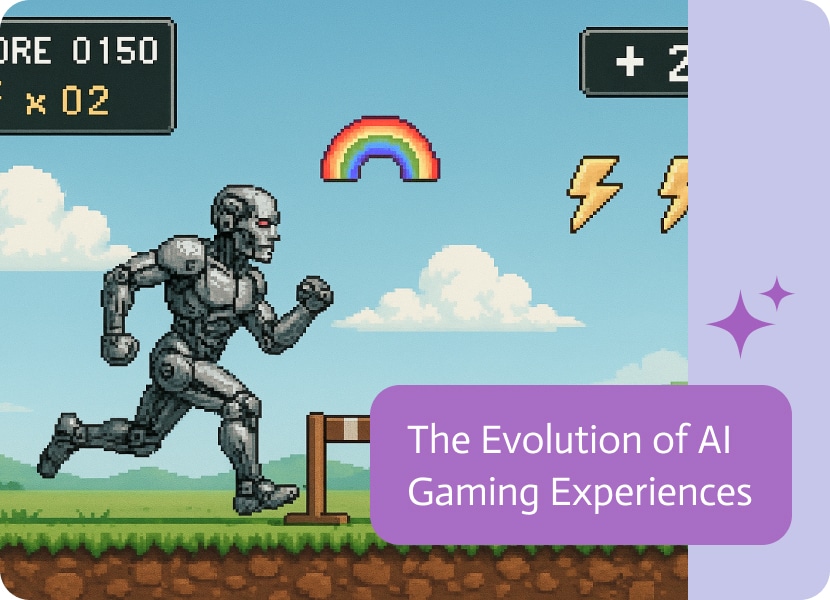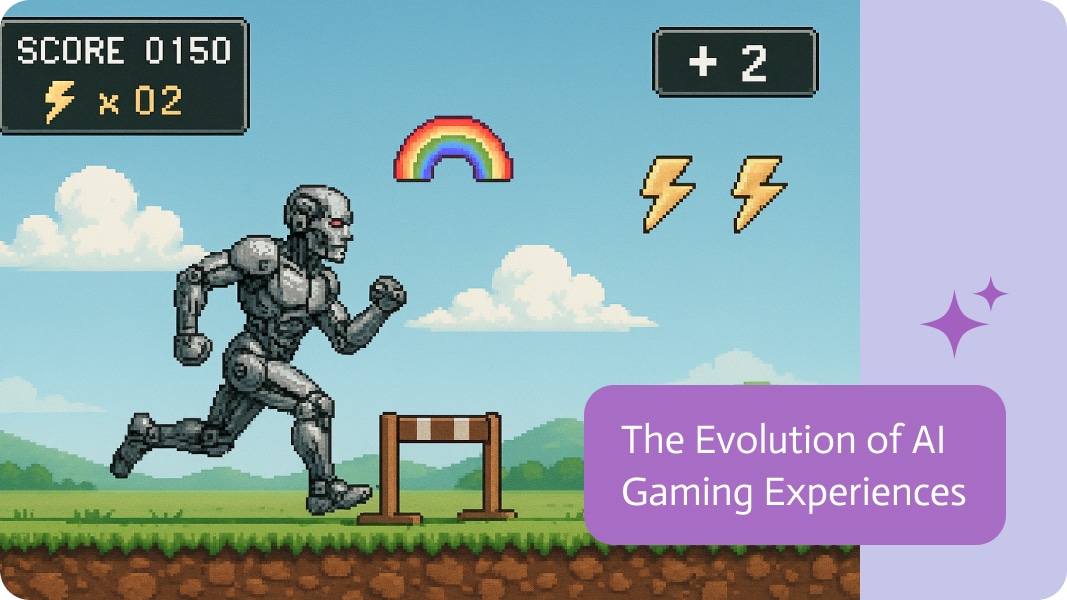

The Evolution of AI Gaming Experiences
Not so long ago, jumping into a video game was almost like opening a coloring book. You grabbed a controller, shot at some reliable foes, and followed a story that never tried to fool you. The scenery flashed and popped, sure, yet it never changed after you left the screen. The bad guys forgot you the moment the power went off, the plots stayed locked in place, and every newcomer replayed the very same level you had just mastered.
AI in Video Games Creating Adaptive Gameplay
Something different is happening now, and it feels almost alive. Artificial intelligence is sneaking into code like yeast into dough, swelling the whole experience and making it breathe. Enemies suddenly adjust their tactics, entire landscapes grow new ruins or treasure chests for the next session, and quests swap dialogue as if the developers are still behind the curtain, still writing. The game no longer sits there waiting; it leans forward, asks one question, and then hits you with two answers you never saw coming.
Remember when those background characters were mere traffic cones? They walked on rails, spat out one-liners, and maybe fired a gun if you crossed an invisible line. Today, an NPC will notice if you keep smashing crates, jaw about loot, and then either help you or set a bounty in town because, guess what, they won’t let a thief slide twice.
On the coding side, a busy little AI brain is counting your moves while you play. It weighs every headshot and every silent takedown. Some of these systems now try new tricks on the spot, teaching themselves the way a teammate would. Suddenly, the next firefight feels totally different, even if it starts in the same alley.
Dynamic Difficulty Adjustment in Modern Games
Difficulty settings used to be a wooden chart of Easy, Normal, and Hard. Choose one, grin, and bear the rest. Now, several titles slip in a quiet adaptive slider that nudges itself based on how often you die or breeze through levels. Gamers with quick reflexes and those still catching on can both walk away satisfied.
Dynamic difficulty adjustment, or DDA for short, makes a massive difference, Picture a silent coach watching your every move, nudging the game so it never feels too easy or impossibly hard. You zip through a few stages? The bad guys get angrier; loot drops feel lighter. Stuck on that one towering boss? Suddenly, the killer takes wild swings, and more health packs appear, all without a neon sign saying you’re being helped.
A second way AI powers up modern games is by spitting out whole worlds from scratch. Procedural generation means a coder can write a few clever algorithms and let the computer build mountains, rivers, and cities while she grabs a coffee. The machine decides where the cliffs rise, where storms roll in, and whether a lone trader camp pops up at sunrise. What pops up on-screen feels giant and hand-crafted, even if nobody lifted a pencil to draw it.
Top Games Using AI for Immersive Experiences
Resident Evil
The action tightens up the moment you coast, but it never yanks the controller out of your hand. The whole idea is simple yet sneaky: keep you locked in the sweet spot where focus meets fun. You play like the master of the universe, even though the game quietly reshapes itself to prove you’re not.
The Last of Us Part II
The bad guys in that title act almost like real people. They shout warnings, share whispers, and even change the plan when they see an ally drop. If you sneak up on one and leave the body behind, another might kneel for a second and look crushed. Something about that tiny scene hits harder than mowing through nameless foes.
No Man’s Sky
This game remains the poster child for real gaming ambition. The game claims more than 18 quintillion worlds-written with an untouchable algorithm-and counts each one as a separate result. Surf one planet, and you might find crimson dunes, turquoise storms, and herds of spined creatures. Jump to another, and you’ll land in swampy fog next to towering mushroom forests. This spread of combinations is so wide that two players will never write the same travel log. Open up the galaxy map, and most pins are still blank, even after hundreds of hours spent looking.
Minecraft
Crafts a brand-new cave system whenever a player digs deep enough, as if the rock is pouring in live. Hades randomly reshuffles the rooms in its underworld every run, meaning the exit door even hides behind a question mark sometimes.
Spelunky
The game rolls its levels fresh whenever you die, and it knows you will die. When the engine itself decides what comes next, replayability stops being a feature and becomes the whole point.
Talking to Characters Like Real People
Most video games stick to a rigid click-this-and-hope-for-the-best style of chat. You pick a line, a canned answer rolls in, and the illusion of choice fades fast. Not long ago, that felt cutting-edge. Now, fresh tech lets players jaw with on-screen pals in a way that actually seems human.
Take AI Dungeon. You bang out a line, hit send, and the system spits out a continuation that, honestly, can be wild. One second you’re escaping lava, and the next you’ve asked a dragon about its weird diet. The surprises pile up, and for a short while, the screen feels oddly alive.
Big-language-brain models keep leveling up. Sooner than later, you might lean toward the mic and say, Hey, listen, we need a better healer, and the NPCs will shrug or agree on the spot. Picture shooters that read your shout of “Shoot that guy!” instead of waiting for button presses or dating games that dodge obvious jokes without ruining the mood. It’s a messy, hopeful sprint toward code that seems to eavesdrop, understand, and chat back like a real friend.
Emergent Storytelling in AI Video Games
AI doesn’t just clean up dialogue; it rewrites the playbook for whole plots. Records of who betrayed whom, who cracked a smile, or who simply ghosted you stay in memory instead of vanishing once the cutscene ends. The world shifts the moment you step away from the main road. Miss a shot in the tutorial, and boom, the sniper squad questions your skills, maybe even your loyalty.
In Middle-earth: Shadow of Mordor, the Nemesis System cooks up one-off enemies who act just like you do. When an orc puts you on the ground, he clings to that moment and will not let you forget it. Smirk at you in a later fight, maybe climb the ladder, and eventually throw a promotion party in your face. That little rivalry turns into personal drama and gives each save file its own wild tale. You reload, and voilà, that’s a brand-new grudge nobody else shares.
Artificial intelligence is pulling writers away from static plotlines. Characters react in real time, so the NPC greeting you by name today might hiss your title tomorrow. Conversation trees reshape themselves the second you earn or lose respect, flipping tone, choices, and even jokes. A few studios have handed the whole plot pencil to the machine, and every player steps into a script that didn’t exist five minutes before they pressed start.
Hiding in the shadows, another layer of AI is hammering away at game polish. Getting a thousand ideas from code is easy; keeping the fun in those ideas is exhausting. Bug hunts and balance checks used to sit solely in the hands of human eyes, and trust me, testers sleep a lot less than you think. Now, algorithms run circuit after circuit, flagging odd jump heights or unfair damage spikes while people sleep, eat, or maybe finish one measly chapter of a book. Using both lets studios catch flaws faster, so you can complain about lag in the finished product instead of the beta.
AI testing bots can play a game level thousands of times faster than any human ever could. They pry into every corner, smash at walls, and find bugs that would probably stay hidden until players dive in for real. That means developers save headaches later, and the launch is usually a lot smoother.
AI Enhancing Game Visuals and Animation
AI isn’t only busy under the hood; it’s also showing off on screen. With NVIDIA’s DLSS, frames get a smart upscaling treatment that tricks the eye into seeing 4K detail while the old card barely breaks a sweat. Mid-range rigs suddenly feel like they’ve got a power-up.
Animation is getting the same kind of shortcut. A voice line can instantly spark a matching eyebrow raise or a quick lip sync, so animators spend way less time pushing keyframes. Hellblade: Senua’s Sacrifice used that tech, and the faces in it don’t just move, they seem to feel. When a digital character looks genuinely shaken, players tend to look away for a second.
Emergent Storytelling in RPGs
We all know the classic Dungeon Master. That single person who controls the universe, invents talking cats on the fly, and rewrites whole chapters because the barbarian just hugged the dragon.
Tech has started making its own DM, featuring your very own party faces and a brand-new monster every hour, not because of printouts, but because an algorithm keeps rewriting the world.
Those handwritten quest logs are gone. Instead, missions pop up based on who is at the table, what shops just burned to the ground, and even which player said, I poke the wizard.
Experimental studios are already tinkering with that idea. The first builds send players running from surprise betrayals, strange allies, and loot that’s booby-trapped the minute you brag about it.
It’s only a matter of time before we can boot up a campaign and let a machine spin the whole yarn while we barely lift a finger, only steering the plot by how loud we cheer or groan.
AI Moderation Fair Play in Online Games
- Swipe into just about any online lobby, and you may bump into trolls, cheaters, or that one buddy who somehow knows how to break every rule.
- Keeping things friendly is basically a second game all on its own. That chore is now being handled by lines of neon code that blink faster than lightning.
- Modern AI scans chat, gameplay patterns, and even mic audio instantly to spot trouble, hand out warnings, or boot offenders before anybody else even blinks.
- Games that once turned into complete chaos after one bad match now stay fun because the machine flags, “Hey, maybe cool it with the slurs,” or “Whoa, those headshot numbers look fake.”
Online gaming’s rough edges are being gently smoothed by algorithmic learning. These days, chat windows, voice channels, and even the cadence of players’ movements on screen are monitored. Before the miscreant has a chance to smirk, the system can intervene, issue a digital red card, and occasionally even impose a ban.
Pattern-detecting code is the backbone, and it silently highlights the sketchy stuff, from aim-bending cheats to see-through-walls hacks, and locks down the account before the suspect blinks. That level of instant response is quickly becoming a must-have for any shooter, racer, or fighter who claims to value fair play.
Future of AI Gaming Experiences and Adaptive Worlds
Picture a game console that flips completely on its head the moment you speak a wish. A foggy woodland smothered in ruins, maybe with vampires haunting the darkness, and BOOM, the world forms while you lean back and blink. Some studio prototypes are already pushing that kind of wild, idea-to-reality generative tech.
Then there’s emotional AI that goes far beyond the reading of scripts. The pixelated buddy on screen might catch the croak in your voice or the scrunch of the face. If you’re fuming at a failed jump, the character could say something calming or, to be honest, poke fun just the right amount. Gaming won’t just be a ride through a pretty set of polygons; it might actually feel like you’re hanging out with somebody who gets you.
Final Thoughts: The Game Is Alive Now
AI has jumped out of the lab and into your living room, completely changing the way we play for real. Just think of heroes that learn your moves, side quests that pop up because of your choices, and whole worlds that shift the minute you look away. That kind of responsiveness turns a simple video session into a story that seems to remember you from yesterday-especially when the consoles are hooked up to the Internet nonstop.
So far, we’ve barely poked the surface, so who knows what the future holds.


